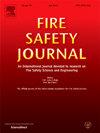航天器材料热解释放的有毒气体和颗粒
IF 3.4
3区 工程技术
Q2 ENGINEERING, CIVIL
引用次数: 0
摘要
在太空活动中,火灾是迫在眉睫的危险。在密封环境中,有毒气体和颗粒的排放可以迅速达到危险水平。为了改善烟雾探测、保护和火灾后的清理,了解与航天器相关的材料热解产生的排放物是至关重要的。本研究研究了四种常见的航天器材料,包括卡普顿、聚四氟乙烯(PTFE)、特氟隆/卡普顿/特氟隆(TKT)绝缘电线和维可牢™的热解,以识别、评估和量化它们的气体和颗粒排放。卡普顿排放大量一氧化碳和氰化氢,聚四氟乙烯和TKT排放多种有毒的氟基气体,包括羰基氟化物和氟化氢,而维可牢™的PM2.5排放系数最高。大多数颗粒尺寸在亚微米范围内,模直径在100-200 nm范围内达到峰值。这些粒子几乎是电中性的,每个粒子携带的净基本电荷少于0.15。有机化合物在颗粒组成中占主导地位。本文章由计算机程序翻译,如有差异,请以英文原文为准。
Toxic gas and particle emissions from the pyrolysis of spacecraft materials
Fire is an imminent risk in space activities. Toxic gas and particle emissions can quickly reach dangerous levels in sealed environments. To improve smoke detection, protection, and post-fire cleanup, understanding the emissions from the pyrolysis of spacecraft-relevant materials is crucial. This study investigated the pyrolysis of four common spacecraft materials, including Kapton, polytetrafluoroethylene (PTFE), Teflon/Kapton/Teflon (TKT) wire insulation, and Velcro™, to identify, evaluate, and quantify their gaseous and particulate emissions. Kapton emitted high levels of carbon monoxide and hydrogen cyanide, PTFE and TKT emitted multiple toxic fluorine-based gases including carbonyl fluoride and hydrogen fluoride, while Velcro™ had the highest PM2.5 emission factor. Most particles were in the submicron size range, with mode diameter peaked in the 100–200 nm range. The particles were nearly electrically neutral, carrying less than 0.15 net elementary charges per particle. Organic compounds predominated in the particle compositions.
求助全文
通过发布文献求助,成功后即可免费获取论文全文。
去求助
来源期刊

Fire Safety Journal
工程技术-材料科学:综合
CiteScore
5.70
自引率
9.70%
发文量
153
审稿时长
60 days
期刊介绍:
Fire Safety Journal is the leading publication dealing with all aspects of fire safety engineering. Its scope is purposefully wide, as it is deemed important to encourage papers from all sources within this multidisciplinary subject, thus providing a forum for its further development as a distinct engineering discipline. This is an essential step towards gaining a status equal to that enjoyed by the other engineering disciplines.
 求助内容:
求助内容: 应助结果提醒方式:
应助结果提醒方式:


